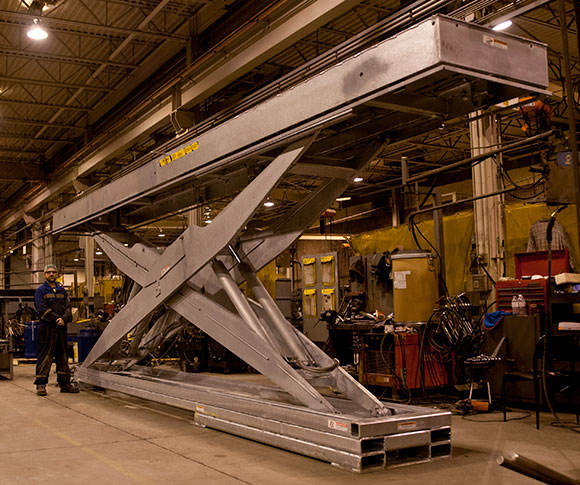
What are the applications for hot dip galvanizing? Hot dip galvanizing is the preferred metal coverage for machinery in applications with corrosive elements or a high level of wash down. Typical applications include food processing operations, chemical processing and pharmaceutical. These applications recognize the benefits of this high performance coating in substantially increasing product life, reducing maintenance and maintaining a required sanitary level. In applications of this nature the benefits of hot dipped galvanizing are significant. Whenever considering hot dip galvanizing the benefits must be considered and weighted against the downside considerations. Each application has its own particular considerations, factors and weighting of those for consideration. In one application a poultry processors loading docks were subject to animal fat acids and regular wash down procedure. This customer found that the life of dock levelers that were hot dipped galvanized were approximately 10 years. The life of painted dock levelers was approximately 1 year. In applications of this nature hot dip galvanizing makes good sense and is a great value.
What is hot dip Galvanizing? It is a coating that is applied to metal to provide superior corrosion protection and resistance.
How is it applied? The metal component is first cleaned by dipping the components into an acid solution. After the acid cleaning dip the component is then dipped into the hot molten galvanizing solution. It should be noted that the hot dip galvanizing process is not completed at the manufacturing facility. The components have to be prepared and sent to an offsite facility that specializes in hot dip galvanizing.
Why is hot dip galvanizing a superior coating to spray paint or other coatings? Due to the high temperature of the solution during the dipping process it adheres extremely securely to the metal surface. The adherence is far superior to the typical paint coating. The chemistry of the coating is highly resistant to corrosion. The chemistry of the coating will actually self-heal in the event of minor scratches and abrasion. Due to the fact the components are dipped and bathed in the solution all surfaces of the component are covered. With spray painted coatings there are almost always areas that are not covered and subject to corrosion. There are no coatings for metal in material handling applications that are superior to galvanizing in resisting and preventing corrosion.
Is cold spray galvanizing equal to hot dip galvanizing? Cold spray galvanizing is not remotely equal to hot dip galvanizing. There are several reasons for this. The components are not dipped in the acid cleaning solution. The components are not dipped in the galvanizing solution. The components are not dipped at all. The compound is sprayed on. All of this results in cold spray galvanizing not being equal at all to hot dip galvanizing. Cold spray galvanizing is simply another sprayed on coating.
What are the down side considerations of hot dip galvanizing? There are numerous downside considerations for hot dip galvanizing. Some of these are listed below:
Cost: Due to the steps involved in the process the cost of hot dip galvanizing is significant. Steps include, shipping of the components to and back from an offsite location that specializes in hot dip galvanizing metal. Reworking prepping of the components for assembly when the components are returned to the manufacturing facility. The reworking can be time consuming based on the fact that when the components are dipped all areas of the component are covered by the coating. Areas such as threads or cavities with specific tolerance requirements will have to be cleaned up to meet tolerance and facilitate a suitable fit. The heat of the process causes certain components to be distorted. The distortion may have to be addressed to facilitate proper fit and operation.
Distortion: As stated above the heat from the process distorts many metal components and welded assemblies when they are dipped into the hot compound. In addition to this distortion resulting in increased manufacturing time, the distortion can result in permanent deflection of components and welded assemblies that could result in operational concerns. For example, the dishing of platform deck plates (which is typical) due to the heat of the galvanizing process can create issues if carts or pallet jacks with small wheels are to be rolled onto or across the platform. If machines with larger wheels and that are powered (such as fork lifts) are driven across, the distortion and deflection becomes less of a concern and in many cases is not noticeable. In some applications in which a high standard of aesthetics is required the resulting distortion could result in aesthetic concerns.
Color Differences: The coating process can result in an inconsistency of surface colours. In some applications with a high expectation for aesthetics the possible colour deviation can be a concern.
Extended Delivery Time: Due to the fact the components have to be sent out, galvanized, shipped back to the manufacturing facility and then prepped additionally for assembly, hot dip galvanizing results in longer delivery lead times.
Related Links :
Get the PDF of Hot Dip Galvanizing - Things you need to know

